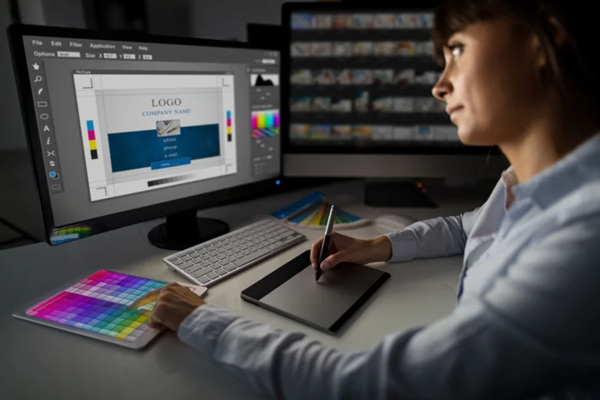General Finance
Want a Graphic Design Job? See Salary, Resume & Intern Tips
Explore essential tips for aspiring graphic designers! Discover salary insights, resume crafting advice, and internship strategies to launch your creative career.
Graphic design is an exciting and dynamic field that harmoniously blends creativity with technology to visually communicate ideas. As the digital media landscape continues to evolve, graphic design has become integral to branding, advertising, and user experience, establishing its importance in today's digital sphere.
Understanding Graphic Design Salaries

Current Salary Trends
Graphic designers' salaries vary significantly based on the industry and role. According to recent data, the average annual salary for graphic designers in the United States stands at approximately $52,000. Those operating within the technology sector often earn more, with averages reaching approximately $66,000, while designers in marketing agencies tend to earn around $46,000. Freelance graphic designers face a fluctuating income landscape, averaging approximately $40,000 annually, which is dependent on their project volume and client base. In recent years, salaries have steadily increased, fueled by the growing demand for digital design capabilities.
Factors Influencing Salary
Experience is a vital factor in determining salary ranges in graphic design. Entry-level designers typically start their careers with salaries ranging from around $40,000, while mid-level designers can expect to earn between $55,000 and $65,000. Senior designers, particularly those with specialised skills, can command salaries exceeding $75,000. Geographic location is another key influencer; for instance, designers employed in major metropolitan hubs, such as San Francisco or New York, commonly earn higher salaries due to both the elevated cost of living and the significant demand for skilled professionals in these areas.
Salary Comparisons by Specialization
Specialisation within the graphic design sector can lead to diverse salary outcomes. For example, UI/UX designers, who focus on optimizing user interfaces and experiences, often earn salaries ranging from $75,000 to $90,000, reflecting both their technical expertise and the industry's demand for their skills. Motion graphics designers, with a specialisation in animation and video production, typically earn an average annual salary of around $65,000. Conversely, traditional roles, such as print designers, may yield lower salaries, typically ranging from $40,000 to $55,000. This trend highlights the growing value of specialised skills in the graphic design job market.
Crafting a Standout Graphic Design Resume
Structuring Your Resume
When creating a graphic design resume, start with essential components—primarily your contact information. This section should prominently display your name, phone number, email address, and general location, facilitating easy outreach from potential employers.
Following this, include a link to your online portfolio, which serves as a showcase for your best work and provides tangible proof of your skills. Next, outline your work experience in reverse chronological order, emphasising relevant positions along with specific responsibilities and key accomplishments. This section not only highlights your professional trajectory but also underscores your adaptability and growth in the field, revealing the depth of your experience to potential employers.
Subsequently, list your educational background, emphasizing degrees obtained and any pertinent certifications. To round off your resume, incorporate a skills section encompassing both technical capabilities—such as proficiency in the Adobe Creative Suite—and essential soft skills like teamwork and communication, which are critical for success in collaborative design environments. Each section should work cohesively to present a well-rounded image of your qualifications and potential.
Showcasing Your Skills
Customizing your skills section is paramount when applying for specific graphic design positions. Carefully analyze job descriptions and ensure your skills align with the employer's requirements. Focus on highlighting key technical abilities, such as web design or typography, that demonstrate your proficiency in areas relevant to the role.
Moreover, don't underestimate the importance of soft skills. Employers consistently seek designers who can effectively communicate concepts and collaborate harmoniously with clients and team members. Skills related to problem-solving and adaptability can help you stand out from other applicants. An effectively crafted skills section not only enhances your resume but also illustrates your comprehensive understanding of the multifaceted nature of design work.
Highlighting Projects and Experience
When detailing your projects and experiences, use descriptive yet concise language to effectively elucidate your role and impact. Concentrate on outcomes—did your design work increase user engagement? Were you able to meet tight deadlines? Including quantifiable metrics can substantially enhance the credibility of your projects.
Keep in mind that your portfolio acts as your visual resume. Ensure that it complements your written content by showcasing diverse projects that highlight both your skills and individual design style. Together, your resume and portfolio should form a cohesive narrative that details your design journey.
Internship Tips for Aspiring Graphic Designers

Finding the Right Internship
When searching for graphic design internships, utilise a combination of online platforms, such as Behance and LinkedIn, where many organisations post job openings. Additionally, make the most of your college's career services and networking events. Attending industry meetups and engaging with professionals can prove vital; referrals often play a significant role in securing internships. Tailoring your search to areas that align with your interests—be it branding, web design, or illustration—can help make your applications more competitive. Approach each application with a well-organised portfolio that showcases your unique style and abilities.
Making the Most of Your Internship
To derive the maximum benefit from your internship, emphasize building strong professional relationships. Be proactive in asking questions and seek constructive feedback regarding your work. Attend team meetings and contribute your ideas actively to demonstrate your initiative and engagement. Networking is essential; establish connections with peers and mentors who can provide guidance and potentially introduce you to future job opportunities. Participating in collaborative projects not only hones your skills but also showcases your ability to function effectively within a team—a crucial aspect of the industry.
Converting Internships into Job Offers
To leave a lasting impression on employers and increase the likelihood of job offers post-internship, consistently deliver high-quality work while maintaining a positive attitude. During your final days, express genuine interest in potential future opportunities. Additionally, a thoughtful follow-up note thanking your employer for the experience can create a memorable impression, potentially paving the way for future employment opportunities.
Your Roadmap to a Thriving Graphic Design Career
In conclusion, aspiring graphic designers must recognise the importance of understanding salary expectations, crafting an impactful resume, and seeking relevant internships to chart their path to success. Grasping the financial landscape facilitates setting realistic career goals, while a well-constructed resume effectively showcases unique skills and experiences. Moreover, internships provide invaluable hands-on experiences and networking opportunities that can unlock doors to permanent positions.
Trending










